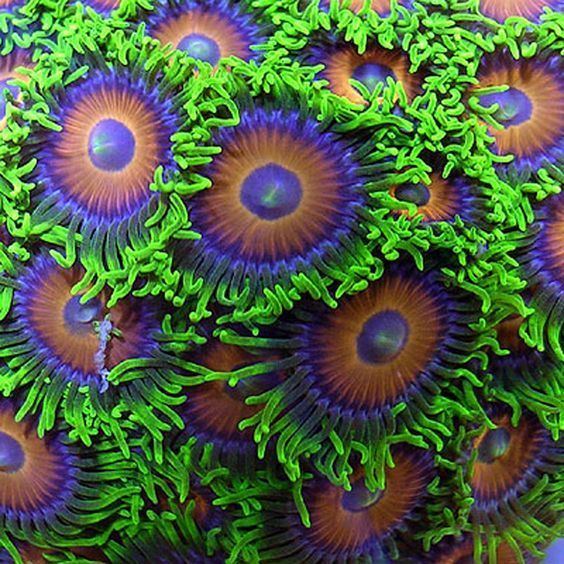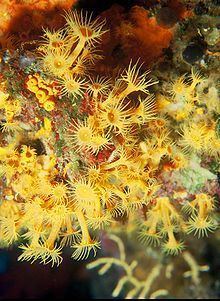Scientific name Zoantharia Rank Order | ||
 | ||
Similar | ||
Zoantharia meaning
Zoanthids (order Zoantharia also called Zoanthidea or Zoanthiniaria) are an order of cnidarians commonly found in coral reefs, the deep sea and many other marine environments around the world. These animals come in a variety of different colonizing formations and in numerous colors. They can be found as individual polyps, attached by a fleshy stolon or a mat that can be created from small pieces of sediment, sand and rock. The term "zoanthid" refers to all animals within this order Zoantharia, and should not be confused with "Zoanthus", which is one genus within Zoantharia.
Contents
- Zoantharia meaning
- Nomenclature controversy
- Characteristics
- Families and genera
- Aquaria
- Dangers
- Diet
- References

They are among the most commonly collected coral in reef aquaria, easily propagating and being very durable in many water conditions.

Nomenclature controversy

The name of the order is controversial. Non-specialists often use the term Zoanthidea whereas most taxonomists use Zoantharia. The term Zoantharia in turn is used temporarily instead of Hexacorallia. However, major taxonomic papers published since 1899 by specialists (O. Carlgren and F. Pax have described more species than all other authors combined) use Zoantharia, and most recent specialists on the order continue to use the term Zoantharia.
Characteristics

Zoanthids can be distinguished from other colonial anthozoans and soft coral by their characteristic of incorporating sand and other small pieces of material into their tissue to help make their structure (except for the family Zoanthidae). The main characteristic of the order is that their tentacles are organized in two distinct rows.

While the most well-known zoanthids are the zooxanthellate genera found in tropical and sub-tropical waters (primarily Zoanthus and Palythoa), many other species and genera exist, some still relatively unknown to science. Many zoanthids (in particular the genera Epizoanthus and Parazoanthus) are often found growing on other marine invertebrates.
Often in zooxanthellate genera such as Zoanthus and Palythoa there are a large number of different morphs of the same or similar species. Such zooxanthellate genera derive a large portion of their energy requirements from symbiotic dinoflagellates of the genus Symbiodinium (zooxanthellae), similar to many corals, anemones, and some other marine invertebrates.
Families and genera
The families and genera within the order Zoantharia (also known as Zoanthidea) are:
Note: there are some zoanthid genera such as Neozoanthus or Paleaozoanthus for which there are currently only few data available, those zoanthids having never been found again since their original description.
Aquaria
Zoanthidae include many species popular in the fishkeeping world, among hobbyists and professionals. They are relatively easy to keep alive and healthy, and will often spread to cover rocks in their bright circles of color. They are known by some as carpet coral, button polyps, and "zoas" or "zoos."
Dangers
Some zoanthids contain the highly toxic substance palytoxin. Palytoxin is one of the most toxic organic substances in the world, but there is an ongoing debate over the concentration of this toxin in these animals. However, even in small quantities, the toxin can be fatal should it be ingested or enter the blood stream. If delivered immediately, it has been suggested that vasodilators can be injected into the ventricle of the heart to act as an antidote.[1] A 2010 study found toxic zoanthids in three Washington D.C. area aquarium stores.
Reports are varied and conflicting on the potential dangers of handling the animal in the aquarist hobby. General opinion and practical experience holds that in order for this toxin to be dangerous to humans, the average aquarist would need to ingest the zoanthid in sufficient quantities, or brush a recent cut over it, and average handling, propagation and aquarium maintenance is unlikely to pose any danger beyond a localized skin reaction.
Other sources state that palytoxin can be absorbed through intact skin, and the danger of acute poisoning from venomous zoanthids is quite real. According to a report an aquarist was poisoned through skin injuries on fingers by a species of Parazoanthus, but recovered after 3 days. His zoanthid was found to contain 2-3 milligram of palytoxin per gram. For comparison, the intravenous LD50 dose of palytoxin for a grown man is less than 8 microgram. Thus each gram of the offending zoanthid contained enough venom to kill at least 125 grown men.
Palytoxin has also been known to damage the eyes of aquarists who attempt to propagate the coral by cutting it and being squirted in the eye. temporary blindness and permanent blindness have been reported. It is always recommended to wear proper eye protection when cutting.
Research shows that in sublethal quantities, Palytoxin is a tumor promoter, and is being studied in relation to signaling pathways in skin cancer genesis.
Generally it is considered proper practice to always wear appropriate protective gloves when reaching into salt water tanks and handling sea invertebrates.
Diet
Zoanthids feed both by photosynthesis, aided by the zooxanthellae they contain, and by capturing plankton and particulate matter. Although photosynthesis aids in their nutrition, even species that do not actively capture plankton cannot live through photosynthesis alone. Zoanthids can eat meaty foods, such as lancefish, brine shrimp, krill and bloodworms.
